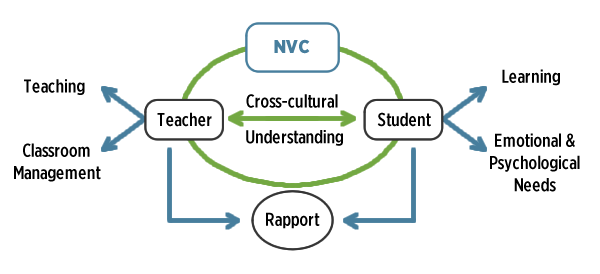
When the American actress Mae West said that she spoke two languages, “Body and English,” she did not realize how big of a role body language plays in teaching English learners (ELs).
Children whose mother tongue is not English have unique educational needs and we, as their teachers, have an obligation to make the necessary adjustments and modifications for meeting those needs. To enable these children to fully participate in the teaching and learning process, the most significant need for them is not only becoming competent in verbal communication in English, but also in the often overlooked, and perhaps more important, nonverbal dimension of communication.
The Importance of Nonverbal Communication
Before educators focus their attention on nonverbal communication (NVC), they must be knowledgeable about the importance of NVC and understand the role it plays in education and communication processes with their language learners. Albert Mehrabian, Professor Emeritus at UCLA, developed the communication model “7-38-55” (Mehrabian,1971). He found that conveying meaning in communication broke down in this way:
- 7% through spoken word
- 38% through tone of voice
- 55% through body language
This means that 93% of communication is conveyed nonverbally—it follows, then, that we must incorporate those nonverbal aspects in our teaching methods. We believe that nonverbal communication (NVC) is deeply rooted in the brain, because the first humans’ communication was dependent on NVC and the utterance of sounds. Mehrabian (1971) reported that a person’s NVC has an enormous influence on their communication with others and strongly influences the reactions they receive.
Additionally, research conducted by Morett et al. (2012) and Pan (2014) suggested that gestures may facilitate acquisition and retention of the target language.
Nonverbal Communication and Multicultural Interactions
Perhaps the greatest influence on the critical 93% of NVC is culture. Nieto (2009) indicated that culture encompasses every aspect of our life and dictates the nature of our interaction with others. Because ELs may come from different countries and cultures, their NVC may greatly differ from that of their classmates, which can have an enormous effect on their interactions and relationships.
The importance of NVC in multicultural interaction cannot be understated. Absent an understanding of NVC, the teaching and learning process can break down entirely: Expression would be not merely ineffective in conveying proper meaning, but misleading or downright wrong, and accurate evaluation of student progress would be impossible.
Types of Nonverbal Communication
The critically important NVC that helps us decode the messages includes
- body movements,
- physical distance between speakers,
- volume of voice,
- touch, and
- use of time in conversation.
We have grouped the NVC in the following categories based on information contained in Communication in the Real World (Anonymous, 2013).
Nonverbal Communication Categories
Kinesics: Refers to body movements, including postures, facial expressions, eye contact, head movement, and gestures
Proxemics: Refers to the space and distance, physically, between communicators
Vocalics: Refers to the vocalized but not verbal aspects of NVC, including tone of voice, speaking rate, volume, tone, and vocal quality
Chronemics: Refers to how time affects communication/use of time in conversation—willingness to wait, punctuality, and interaction between interlocutors
Haptics: Refers to touch
Based on our personal and professional experience working with ELs in multiple countries and on multiple continents, nonverbal features of communication should receive more attention in teaching ELs.
Nonverbal Communication in the Classroom
Bachmann (1973) has taught us that one of the most important English language teaching goals is that the teachers themselves must first understand the rich array of their own NVC. Following this, they can help their students understand, recognize, and incorporate relevant and appropriate NVC factors, stemming from the target culture, while conversing in English. Bachmann (1973) shared a few insightful ideas of how ESL teachers could spark students’ interest to achieve this goal:
-
Dialogues should be acted out in the classroom, incorporating the critical elements of body language.
-
Films could be used for teaching the target culture’s NVC, with teachers calling students’ attention to the body language used in the film.
-
Role-playing can be very effective because various gestures, facial expressions, and distances can be illustrated and practiced.
Speakers’ proficiency in second language NVC has a significant influence on their competence in communicating in the second language. NVC can send a strong message that may support or conflict with what is being said with words. Knowing your learners is an important part of teaching NVC: Once you have a working understanding of your students’ cultures, you will be better able to understand how it influences your students’ NVC, which is culture specific.
Based on our literature review and anecdotes from personal experience (see the Appendix), we propose the chart shown in Figure 1; it illustrates the impact of intercultural competence on NVC, which consequently affects (latent) variables in the educational process.

Figure 1. The impact of cross-cultural
understanding on nonverbal communication between teacher and English language
student. Click here to enlarge.
As seen in Figure 1, NVC between a teacher and their English language student is a cyclical process during production of the message, for both individuals. For this process to flow smoothly, it is necessary to have certain shared knowledge about each other’s cultures.
Encouraging Cross-Cultural Understanding Between Teacher and Student
Teachers’ misinterpretations of ELs’ NVC can be alleviated in a number of ways, including the following.
Engage in cross-cultural professional development. Professional development specifically targeting the growth of cross-cultural skills will help educators who work with ELs appreciate other cultures and people who are different from them and also accept the fact that different does not mean bad.
Ask questions. Teachers of ELs should ask questions to find out who their students are, what they like, what they value, what they believe in, how they learn, and so on. When we listen to our students’ stories, seek to know the things that matter to them, and show our genuine interest in their lives, the doors to their hearts open and an incredible connection is created.
Share about yourself. We should be equally interested in sharing aspects of our own language, customs, and traditions; this mutual cultural exchange helps us to learn about each other, better understand differences, and conclude what is important and unique in the cultures we have in the classrooms.
Build a safe, welcoming, and positive environment. Having positive teacher–student rapport can establish a comfortable classroom environment where students feel happy and relaxed. This can lead to students being more invested in class and actively participating in the teaching and learning process (Pack, 2018).
A Note in Closing
We would like to emphasize that we do not wish to teach NVC formally to our ELs in order to make them look more like native speakers. Birdwhistel (as cited in Bachman, 1973) explained that doing so might lead to the students “being judged insincere and affected” (p. 10). Imitations are insufficient. Rather, students should be able “to recognize and…use appropriate gestures and facial expressions for a given situation” (p. 10).
We recommend teachers learn about observational learning and its stages (attention, retention/memory, motor/initiation, and motivation) to better assist their ELs to succeed in NVC.
Our findings suggest that cross-cultural knowledge plays a significant role in understanding NVC in multicultural interactions between a teacher and ELs. This comprehension positively affects the overall educational process. The existing research focusing on multicultural NVC is notably limited and provides insufficient content particular to decoding students’ NVC.
References
Anonymous. (2013). Types of nonverbal communication – Communication in the real world. University of Minnesota Libraries.
Bachmann, J. K. (1973, May 9–13). English face-to-face: The non-verbal dimension of conversation [Paper presentation]. Teachers of English to Speakers of Other Languages Annual Convention, San Juan, Puerto Rico.
Mehrabian, A. (1971). Silent Messages. Wadsworth.
Morett, L. M., Gibbs, R., & MacWhinney, B. (2012). The role of gesture in second language learning: Communication, acquisition, & retention. Proceedings of the Annual Meeting of the Cognitive Science Society, 34. https://cholarship.org/uc/item/65t0v6xc
Nieto, S. (2009). Language, culture, and teaching: Critical perspectives. Routledge.
Pack, A. (2018). Teacher introduction activity for improving rapport and critical thinking. English Teaching Forum, 56(4), 34–36.
Pan, Q. (2014). Nonverbal teacher-student communication in the foreign language classroom.Theory and Practice in Language Studies,4(12), 2627–2632.
|
Download this article (PDF) |
Zuzana Gorleku is an adjunct professor at Concordia University. She has lived, studied, and worked in three different countries and has experience teaching in the Eastern European, British, and American educational systems, where she was able to implement various teaching methods and best practices in foreign language instruction. Her professional identity is centered around teaching ESL and international students.
Sherzod Amanbaev is a doctoral student at Aurora University. As an ESL instructor in various institutions in Uzbekistan and the United States, he gained valuable experience with diverse multicultural students. His current research focuses on the development of education in Central Asia beginning in the twentieth century, identity building, and the study of foreign languages.
